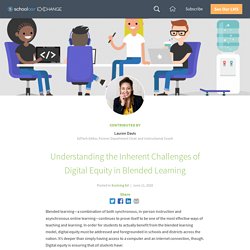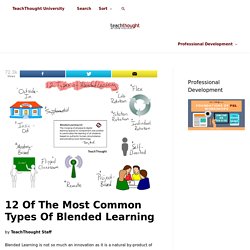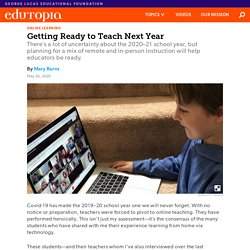

They also give some direction on different types of distance/blended learning. With so much uncertainty with the upcoming school year, I believe it is important to develop the best toolbox of distance learning, in order to be flexible as changes occur. What Does Remote Instructional Leadership Look Like During a Pandemic? - Peter DeWitt's Finding Common Ground. For most educators and students around the globe, this has been the hardest spring of their lives.

At first we thought our schools would be closed for a week, which then was extended to a couple of weeks. We now know, that this has turned into closing schools for the rest of the year for most states within the US. In the U.K. they are looking at a hybrid model of return to school for students, and in Canada, some provinces are not allowing students to return until the fall, while others are bringing back primary students in a hybrid model, as secondary students remain in a full-on remote learning experience.
Understanding the Inherent Challenges of Digital Equity in Blended Learning. Blended learning—a combination of both synchronous, in-person instruction and asynchronous online learning—continues to prove itself to be one of the most effective ways of teaching and learning.

In order for students to actually benefit from the blended learning model, digital equity must be addressed and foregrounded in schools and districts across the nation. It’s deeper than simply having access to a computer and an internet connection, though. How Can Educators Tap Into Research to Increase Engagement During Remote Learning? As university professors and researchers who work closely with K-12 online teachers and learners, we’ve heard from many newly remote educators who are struggling.

Recent class discussions have focused on the difficulties of getting through to students without in-person contact, especially during a time of enormous stress. Some teachers report that their students lack interest and in the worst cases, that students are dropping from classes entirely. From our experience both in the online classroom and in training teachers to teach online, this is familiar territory and typically happens about six weeks into a new school session. The newness has worn off, the excitement around technology wanes and teachers often struggle finding ways to engage with their students. The crucial question that has emerged is: how do we engage learners when we are not together physically? There isn’t one solution for increasing learner engagement and motivation. 12 Different Types of Blended Learning. By TeachThought Staff Blended Learning is not so much an innovation as it is a natural by-product of the digital domain creeping into physical spaces.

Broadly speaking, blended learning just means a mix of learning online and face-to-face, which means it’s likely your students are already doing some form of blended learning and have for years. As digital and social media become more and more prevalent in the life of learners, it was only a matter of time before learning became ‘blended’ by necessity. Finding The Model That Works For Your School, Classroom, And Students. 3 Strategies for Personalizing Feedback Online. Feedback is one of the most powerful tools teachers have in their “teaching toolbelts” for guiding learners toward mastery.

Without feedback, students do not have a clear sense of what they are doing well, what they need to focus on, and what they can do to improve. Despite the power of timely and actionable feedback, it is easy to neglect. Providing feedback is time-consuming and often takes a back seat to other aspects of our work. Teachers must find ways to give feedback that are sustainable and effective. In the absence of face-to-face classes, teachers can communicate they care about their students’ progress by providing them with feedback on their work. Research indicates that using media, beyond text comments, positively impacts the students’ perception of the quality of feedback. Getting Ready to Teach in K-12 Schools Next Year. Covid-19 has made the 2019–20 school year one we will never forget.

With no notice or preparation, teachers were forced to pivot to online teaching. They have performed heroically. This isn’t just my assessment—it’s the consensus of the many students who have shared with me their experience learning from home via technology. These students—and their teachers whom I’ve also interviewed over the last six weeks—are far less sanguine about online learning, however, with real concerns about its quality and effectiveness. 5 Traps That Will Kill Online Learning (and Strategies to Avoid Them) For perhaps the first time in recent memory, parents and teachers may be actively encouraging their children to spend more time on their electronic devices.

Online learning has moved to the front stage as 90 percent of high-income countries are using it as the primary means of educational continuity amid the COVID-19 pandemic. If March will forever be remembered as the month that virtually all the world’s countries closed their school doors, will April be remembered as the month that the students around the world embraced the world of online learning? There is no shortage of optimistic speculation from education experts and innovators that this experience will have a transformative effect on education after the pandemic is over. I certainly hope this will be true.